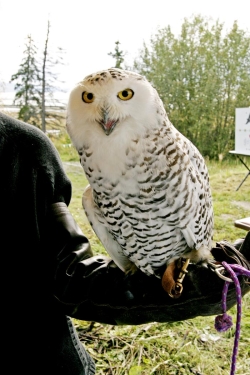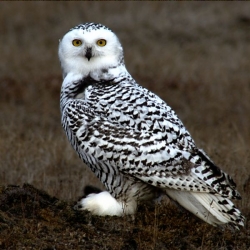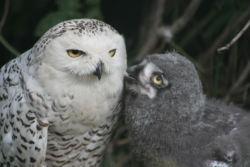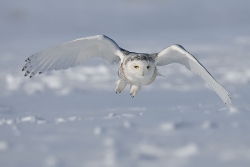
Bubo scandiacus
Courtesy US FWS
Ronald Laubenstein, Photographer Snowy Owl in Alaska
Snowy Owl in Alaska
Bubo scandiacus
Courtesy Wikimedia
Floyd Davidson, Photographer
Licensed under the
Creative Commons: GNU Free Documentation License Snowy Owl with Chick
Snowy Owl with Chick
Bubo scandiacus
Courtesy Wikimedia
Tony Hisgett, Photographer
Licensed under the
Creative Commons: Attribution 2.0 Generic License Snowy Owl in Flight
Snowy Owl in Flight
Bubo scandiacus
Courtesy Wikimedia
Bert de Tilly, Photographer
Licensed under the
Creative Commons: Attribution-Share Alike 3.0 Unported License
Maybe you’ve seen some headlines or blog titles this winter: Snowy owls invading the US or Scientists bewildered by mass migration of snowy owls from the Arctic.
What’s going on? The thought of bewildered scientists makes me uneasy. Should we be concerned or should we be delighted at the prospect of maybe seeing one of these ethereal birds?
A dramatic increase of a single species outside its usual habitat is called an irruption—that’s irruption with an “i” not an “e.” Snowy owl irruptions are usually attributed to periodic spikes in the population of their favorite snack—the lemming. In an a year with plentiful food resources, an owl can lay up to 10 or 11 eggs! Having lots of baby snowy owls in the nest forces the parents to hunt more. Eventually, the lemming supply crashes and by winter you have a large, hungry population of owls, some of which must disperse far and wide to search for food.
A rise and fall of lemming numbers likely did occur in 2011, causing a lot more snowy owls to move south. But is this year really as amazing as it seems? Consider: The number of people birding in 2001 grew 232 percent above the number involved in birding in 1983. And the total has grown still more over the last decade. More bird counters = more sightings. In fact, a single bird might be sighted and counted many times by these rapidly multiplying bird counters.
Furthermore, the counters–and even people who don’t count—are recording and storing all their personal bird sightings online. The most popular storage tank is a checklist program called eBird. Personal and group records in eBird are amassed together into a giant global database. Ebird uses this database to create figures, summaries and maps which are available to anyone. It’s eBird’s map of snowy owls that is being cited in blogs and newspaper articles. The map clearly shows a remarkable number of snowies decending upon the lower 48 especially in the Great Plains region. Everyone can agree that it’s a great year but still, you can’t help but question if the much higher counts are partly due to the spiraling rates of human counting and reporting.
Here in Utah there have been two recorded sightings this winter—one in the Bear Lake Valley and one on the causeway to Antelope Island. Not what I’d call an invasion, but these two sightings do represent the first ever records of snowy owls on Ebird. However, if you snoop around enough you’ll find there have been sporadic sightings in Utah dating back to 1908.
For pictures, sources and links go to WWW.Wildaboututah.org
For Wild About Utah, I’m Holly Strand.
Credits:
Images: Courtesy US FWS, Ronald Laubenstein, Photographer; and
Courtesy Wikimedia, Photographers: Floyd Davidson, Tony Hisgett, Bert de Tilly.
Text/Voice: Holly Strand
Sources & Additional Reading:
eBird [Accessed February 16, 2012]. Distribution and frequency map machine. https://ebird.org/ebird/map/snoowl1?&eyr=2012 and The Winter of the Snowy Owl (February 2, 2012) https://ebird.org/content/ebird/news/the-winter-of-the-snowy-owl
Kerlinger, P. and M. Ross Lein. 1988. Population Ecology of Snowy Owls during Winter on the Great Plains of North America in The Condor, Vol. 90, No. 4 pp. 866-874. URL: https://www.jstor.org/stable/1368844 [Accessed February 15, 2012]
Parmelee, David F. 1992. Snowy Owl (Bubo scandiacus), The Birds of North America Online (A. Poole, Ed.). Ithaca: Cornell Lab of Ornithology; Retrieved from the Birds of North America Online: formerly: https://bna.birds.cornell.edu/bna/species/010 [Accessed February 16, 2012]
Snowy Owl, Birds of the World, The Cornell Lab of Ornithology, Cornell University, https://birdsoftheworld.org/bow/species/snoowl1/cur/introduction
Utah Birds Rare Bird sightings in Utah https://www.utahbirds.org/RecCom/RareBirds3.htm#SnowyOwl[Accessed February 16, 2012]
Link to Youtube video “Snowy Owl Invasion” produced by the Cornell Lab of Ornithology: https://www.youtube.com/LabofOrnithology [Accessed February 16, 2012]
Alternate URL: https://www.youtube.com/watch?v=Ufkcx-UqljM&list=PLA20B4F3F9F421EC9
Webmaster picks:
Laura Erickson, The Owls of Harry Potter, https://lauraerickson.com/bird/Species/Owls/HarryPotter/HarryPotter.html
Snowy Owls swoop down from the arctic, Kristen Dahlgren, MSNBC, https://video.msnbc.msn.com/nightly-news/46228248#46228719
Photographer waited ‘long time’ for snowy owl to come back, MSNBC, https://video.msnbc.msn.com/nightly-news/46228248#46228248
Reaction to Snowy Owl “Wow”, MSNBC, https://video.msnbc.msn.com/nightly-news/46228248#46226508
